The rise in the number of encampments in Toronto was invariably going to lead to tents being erected in an environmentally sensitive area (ESA). While alarming (and rightly so) to nature lovers, this issue is multifaceted, involving environmental conservation, public safety, and human rights.
From an environmental standpoint, tent encampments can pose significant risks to fragile ecosystems. These areas often serve as habitats for endangered species, play critical roles in maintaining biodiversity, or are the last remnants of a once widespread ecosystem. Human activity, waste, and makeshift infrastructure in such locations can lead to soil degradation and habitat destruction. For example, vegetation underneath tents can die from lack of light and water.
However, encampments are often a last resort for individuals who lack safe, indoor housing. Public spaces, including parks and natural areas, can seem like the only available refuge for those who can’t use shelters due to overcrowding or safety concerns. Unhoused people are unlikely to know that the area they selected is an ESA as they are just looking for safety and privacy.
This scenario played out in the Autumn of 2024 when a tent was erected in the High Park Savannah ESA. Fearing the destruction of this sensitive habitat, concerned citizens called 311, wrote to their councillor, talked to people at City Hall, and got others to do the same. Importantly, they did not confront the individual themselves.
After the initial 311 report, the City sent Encampment Outreach & Response staff to talk to the unhoused individual and assess the situation. The individual was willing to move to a shelter, but with over 220 people being turned away from full shelters per day, there wasn’t anything available. The intervention may have ended there, but with continued pressure from people concerned about the destruction in the ESA, City staff continued to work on the situation.
Eventually, the individual was removed from the ESA with police, shelter staff, and paramedics on scene. While I hope the individual receives the support they need, it’s important to note that connecting with shelter services and being sent to the ER does not always lead to long-term care or address underlying mental health or housing issues. It is a complex situation.
I am glad that there were people willing to speak up for the ESA and see that it was protected, and it highlights the power of public pressure. But this was a special case since the tent was in an ESA. It should not be a nature-lovers response to all encampments in parks. People living outside are an indication of the lack of support for those without homes, with mental health issues, or substance use problems. If we want tents out of parks then we should be advocating for more support for these individuals, not more evictions. The humane response when passing by a tent in a park is to give the occupants space and privacy.
This issue underscores the complexity and interconnectedness of social and environmental challenges. Addressing homelessness and protecting natural areas are not mutually exclusive goals, but achieving both requires thoughtful, coordinated efforts.

